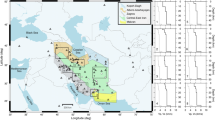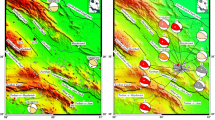Abstract
Determination of the focal mechanism of microseismic (MS) events occurring in rock engineering plays an important role in hazard evaluation and forecasting. A complete moment tensor inversion strategy is proposed to analyse MS events recorded at the left bank slope of the Baihetan hydropower station, southwest of China. A coordinate system rotation procedure is adopted to construct a reliable 1-D velocity model for the Green’s function calculation. The layered velocities are accurately determined by inversion using the recorded blasts and geological survey results. To reduce the influence of noise contamination, only the waveforms in the frequency range of 60–150 Hz are analysed. Before moment tensor inversion, a relocation procedure using an eikonal solver is performed to accurately locate seismic sources. A robust global optimization routine is applied to maximize the objective function, thereby determining the focal mechanism. The proposed method is tested using a hypothetical seismic source in the sensor network used for monitoring MS events in the rock slope. The synthetic test shows that the method is robust and can provide accurate solutions when subject to location error, noise contamination and velocity model disturbances. The analysis results of the 12 MS events show that the moment tensors characterizing MS events present significant non-double-couple components and that the majority of the MS events have a strike orientation in accordance with that of the main staggered zones.













Similar content being viewed by others
References
Aki K, Richards PG (2002) Quantitative seismology. University Science Books, Sausalito
Baig A, Urbancic T (2010) Microseismic moment tensors: a path to understanding frac growth. Lead Edge 29(3):320–324
Bouchon M (1981) A simple method to calculate Green’s function for elastic layered media. Bull Seism Soc Am 71(4):959–971
Bouchon M (2003) A review of the discrete wavenumber method. Pure Appl Geophys 160(3–4):445–3465
Carvalho J, Barros LV, Zahradík J (2015) Focal mechanisms and moment magnitudes of micro-earthquakes in central Brazil by waveform inversion with quality assessment and inference of the local stress field. J S Am Earth Sci. https://doi.org/10.1016/j.jsames.2015.07.020
Dai F, Li B, Xu NW, Meng G, Wu J, Fan YL (2017) Microseismic monitoring of the left bank slope at the Baihetan hydropower station, China. Rock Mech Rock Eng 50(1):225–232
Gharti HN, Oye V, Roth M, Kühn D, Roth M (2010) Automated microearthquake location using envelope stacking and robust global optimization. Geophysics 75(4):27–46
Hassouna MS, Farag AA (2007) Multistencils fast marching methods: a highly accurate solution to the eikonal equation on Cartesian domains. IEEE Trans Pattern Anal Mach Intell 29(9):1563–1574
Jiang Q, Feng XT, Hatzor YH, Hao XJ, Li SJ (2014) Mechanical anisotropy of columnar jointed basalts: an example from the Baihetan hydropower station, China. Eng Geol 175:35–45
Jost ML, Herrmann RB (1989) A student’s guide to and review of moment tensors. Seismol Res Lett 60(2):37–57
Köhn D, De Nil D, Hagrey SA, Al Rabbel W (2016) A combination of waveform inversion and reverse-time modelling for microseismic event characterization in complex salt structures. Environ Earth Sci 75(18):1235
Kühn D, Vavryčuk V (2013) Determination of full moment tensor of microseismic events in a very heterogeneous mining environment. Tectonophysics 589:33–43
Li JL, Zhang HJ, Kuleli HS (2011) Focal mechanism determination using high-frequency waveform matching and its application to small magnitude induced earthquakes. Geophys J Int 184(3):1261–1274
Liu JP, Feng XT, Li YH, Xu SD, Sheng Y (2013) Studies on temporal and spatial variation of microseismic activities in a deep metal mine. Int J Rock Mech Min Sci 60:171–179
Lu CP, Liu GJ, Liu Y, Zhang N, Xue JH, Zhang L (2015) Microseismic multi-parameter characteristics of rockburst hazard induced by hard roof fall and high stress concentration. Int J Rock Mech Min Sci 76:18–32
Šílený J, Milev A (2006) Seismic moment tensor resolution on a local scale: simulated rockburst and mine-induced seismic events in the Kopanang gold mine, South Africa. Pure Appl Geophys 163(8):1495–1513
Šílený J, Hill DP, Eisner L, Cornet FH (2009) Non-double-couple mechanisms of microearthquakes induced by hydraulic fracturing. J Geophys Res. https://doi.org/10.1029/2008JB005987
Sokos EN, Zahradnik J (2008) ISOLA a Fortran code and a Matlab GUI to perform multiple-point source inversion of seismic data. Comput Geosci 34(8):967–977
Song FX, Toksöz MN (2011) Full-waveform based complete moment tensor inversion and source parameter estimation form downhole microseismic data for hydrofracture monitoring. Geophysics 76(6):103–116
Stockwell RG, Mansinha L, Lowe R (1996) Localization of the complex spectrum: the S transform. IEEE Trans Signal Process 44(4):998–1001
Storn R, Price K (1995) Differential evolution: a simple and efficient adaptive scheme for global optimization over continuous spaces. Berkeley: Tech Rep TR-95-012 ICSI
Storn R, Price K (1997) Differential evolution—a simple and efficient heuristic for global optimization over continuous spaces. J Glob Optim 11(4):341–359
Tang LZ, Xia KW (2010) Seismological method for prediction of areal rockbursts in deep mine with seismic source mechanism and unstable failure theory. J Cent South Univ Technol 17(5):947–953
Vavryčuk V (2001) Inversion for parameters of tensile earthquakes. J Geophys Res 106(B8):16339–16355
Vavryčuk V (2007) On the retrieval of moment tensors from borehole data. Geophys Prospect 55(3):381–391
Vavryčuk V, Kühn D (2012) Moment tensor inversion of waveforms: a two-step time-frequency approach. Geophys J Int 190(3):1761–1776
Wamboldt L (2012) An automated approach for the determination of the seismic moment tensor in mining environments. M.S. Thesis. Queen’s University, Kingston, Ontario, Canada
Xiao YX, Feng XT, Feng GL, Liu HJ, Jiang Q, Qiu SL (2016) Mechanism of evolution of stress–structure controlled collapse of surrounding rock in caverns: a case study from the Baihetan hydropower station in China. Tunn Undergr Sp Technol 51:56–67
Xu NW, Tang CA, Li LC, Zhou Z, Sha C, Liang ZZ, Yang JY (2011) Microseismic monitoring and stability analysis of the left bank slope in Jinping first stage hydropower station in southwestern China. Int J Rock Mech Min Sci 48(6):950–963
Xu NW, Dai F, Liang ZZ, Zhou Z, Sha C, Tang CA (2014) The dynamic evaluation of rock slope stability considering the effects of microseismic damage. Rock Mech Rock Eng 47(2):621–642
Xu NW, Li TB, Dai F, Li B, Zhu YG, Yang DS (2015) Microseismic monitoring and stability evaluation for the large scale underground caverns at the Houziyan hydropower station in Southwest China. Eng Geol 188:48–67
Xu NW, Li TB, Dai F, Zhang R, Tang CA, Tang LX (2016a) Microseismic monitoring of strainburst activities in deep tunnels at the Jinping II hydropower station, China. Rock Mech Rock Eng 49:981–1000
Xu NW, Dai F, Zhou Z, Jiang P, Zhao T (2016b) Microseismicity and its time–frequency characteristics of the left bank slope at the Jinping first-stage hydropower station during reservoir impoundment. Environ Earth Sci 75(7):608. https://doi.org/10.1007/s12665-016-5539-z
Zhang J, Zhang HJ, Chen EH, Zheng Y, Kuang WH, Zhang X (2014) Real-time earthquake monitoring using a search engine method. Nat Commun. https://doi.org/10.1038/ncomms6664
Acknowledgements
The authors are grateful for the financial support from the National Natural Science Foundation of China (51679158), National Program on Key basic Research Project (No. 2015CB057903) and the Opening fund of State Key Laboratory of Geohazard Prevention and Geoenvironment Protection (Chengdu University of Technology) (No. SKLGP2016K018).
Author information
Authors and Affiliations
Corresponding author
Rights and permissions
About this article
Cite this article
Dai, F., Jiang, P., Xu, N. et al. Focal mechanism determination for microseismic events and its application to the left bank slope of the Baihetan hydropower station in China. Environ Earth Sci 77, 268 (2018). https://doi.org/10.1007/s12665-018-7443-1
Received:
Accepted:
Published:
DOI: https://doi.org/10.1007/s12665-018-7443-1




